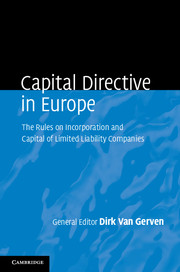Book contents
- Frontmatter
- Contents
- Contributors
- Preface
- Part I
- Part II National reports for the EU Member States
- 2 Austria
- 3 Belgium
- 4 Bulgaria
- 5 Cyprus
- 6 Czech Republic
- 7 Denmark
- 8 Estonia
- 9 Finland
- 10 France
- 11 Germany
- 12 Greece
- 13 Hungary
- 14 Ireland
- 15 Italy
- 16 Latvia
- 17 Lithuania
- 18 Luxembourg
- 19 Malta
- 20 The Netherlands
- 21 Poland
- 22 Portugal
- 23 Republic of Slovenia
- 24 Romania
- 25 Slovak Republic
- 26 Spain
- 27 Sweden
- 28 United Kingdom
- Part III Application in the EEA Member States
- Part IV Annexes
- Index
8 - Estonia
from Part II - National reports for the EU Member States
Published online by Cambridge University Press: 05 June 2014
- Frontmatter
- Contents
- Contributors
- Preface
- Part I
- Part II National reports for the EU Member States
- 2 Austria
- 3 Belgium
- 4 Bulgaria
- 5 Cyprus
- 6 Czech Republic
- 7 Denmark
- 8 Estonia
- 9 Finland
- 10 France
- 11 Germany
- 12 Greece
- 13 Hungary
- 14 Ireland
- 15 Italy
- 16 Latvia
- 17 Lithuania
- 18 Luxembourg
- 19 Malta
- 20 The Netherlands
- 21 Poland
- 22 Portugal
- 23 Republic of Slovenia
- 24 Romania
- 25 Slovak Republic
- 26 Spain
- 27 Sweden
- 28 United Kingdom
- Part III Application in the EEA Member States
- Part IV Annexes
- Index
Summary
Implementation and scope
The Commercial Code, which is the main source of company and corporate law in Estonia, entered into force on 1 September 1995. Although Estonia did not become an EU Member State until 1 May 2004, the regulation set out in the Second Company Law Directive as amended by Directive 92/101/EEC of 23 November 1992 was already the main basis for drafting the respective parts of the Commercial Code. The amendments to the Directive introduced by Directive 2006/68/EC of 6 September 2006 were implemented by the Act on Amendment of Act on Implementation of the Commercial Code and Council Regulation (EC) No 2157/2001 on the Statute for a European company (SE) of 20 March 2008.
The scope of the Second Company Law Directive is limited to public limited liability companies (see no 1 of Chapter 1). In accordance with the Directive, aktsiaselts (“AS”) is the public limited liability company under Estonian law to which the Directive applies. The Estonian legislature has extended some of the rules of the Directive to also cover osaühing (“OÜ”). However, there are still a number of exceptions to these rules, which shall not be further discussed in this chapter.
- Type
- Chapter
- Information
- Capital Directive in EuropeThe Rules on Incorporation and Capital of Limited Liability Companies, pp. 257 - 282Publisher: Cambridge University PressPrint publication year: 2014



